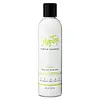What's inside
What's inside
 Key Ingredients
Key Ingredients

 Benefits
Benefits

 Concerns
Concerns

 Ingredients Side-by-side
Ingredients Side-by-side

Water
Skin ConditioningSodium Cocoyl Isethionate
CleansingCocamidopropyl Betaine
CleansingSodium Methyl Cocoyl Taurate
CleansingSodium Chloride
MaskingParfum
MaskingGlycerin
HumectantCetearamidoethyldiethonium Succinoyl Hydrolyzed Pea Protein
CleansingHypnea Musciformis Extract
Skin ProtectingSargassum Filipendula Extract
Skin ProtectingChamomilla Recutita Flower Extract
MaskingHelianthus Annuus Seed Oil
EmollientMangifera Indica Seed Butter
Skin ConditioningPersea Gratissima Oil
Skin ConditioningRicinus Communis Seed Oil
MaskingCoco-Glucoside
CleansingGelidiella Acerosa Extract
Skin ProtectingAlgin
MaskingCarrageenan
Chitosan
Cocamide Mipa
EmulsifyingPEG-200 Hydrogenated Glyceryl Palmate
CleansingPhenoxyethanol
PreservativeGlycol Stearate
EmollientPropanediol
SolventCoconut Acid
CleansingSodium Isethionate
CleansingPEG-7 Glyceryl Cocoate
EmulsifyingGlyceryl Stearate
EmollientPEG-100 Stearate
Guar Hydroxypropyltrimonium Chloride
Skin ConditioningCaprylyl Glycol
EmollientCitric Acid
BufferingEthylhexylglycerin
Skin ConditioningIsopropanolamine
BufferingMethyl Cocoate
EmollientTocopherol
AntioxidantSorbitol
HumectantCaprylic/Capric Triglyceride
MaskingSorbitan Oleate
EmulsifyingXanthan Gum
EmulsifyingCoumarin
PerfumingLinalool
PerfumingWater, Sodium Cocoyl Isethionate, Cocamidopropyl Betaine, Sodium Methyl Cocoyl Taurate, Sodium Chloride, Parfum, Glycerin, Cetearamidoethyldiethonium Succinoyl Hydrolyzed Pea Protein, Hypnea Musciformis Extract, Sargassum Filipendula Extract, Chamomilla Recutita Flower Extract, Helianthus Annuus Seed Oil, Mangifera Indica Seed Butter, Persea Gratissima Oil, Ricinus Communis Seed Oil, Coco-Glucoside, Gelidiella Acerosa Extract, Algin, Carrageenan, Chitosan, Cocamide Mipa, PEG-200 Hydrogenated Glyceryl Palmate, Phenoxyethanol, Glycol Stearate, Propanediol, Coconut Acid, Sodium Isethionate, PEG-7 Glyceryl Cocoate, Glyceryl Stearate, PEG-100 Stearate, Guar Hydroxypropyltrimonium Chloride, Caprylyl Glycol, Citric Acid, Ethylhexylglycerin, Isopropanolamine, Methyl Cocoate, Tocopherol, Sorbitol, Caprylic/Capric Triglyceride, Sorbitan Oleate, Xanthan Gum, Coumarin, Linalool
Water
Skin ConditioningSodium C14-16 Olefin Sulfonate
CleansingCocamidopropyl Betaine
CleansingCocamide Mea
EmulsifyingGlycol Distearate
EmollientSteareth-4
EmulsifyingGlycerin
HumectantHydroxypropyltrimonium Honey
Silk Amino Acids
HumectantHypnea Musciformis Extract
Skin ProtectingGelidiella Acerosa Extract
Skin ProtectingSargassum Filipendula Extract
Skin ProtectingSorbitol
HumectantRosmarinus Officinalis Leaf Extract
AntimicrobialSalix Alba Bark Extract
AstringentUrtica Dioica Extract
AstringentTocopheryl Acetate
AntioxidantPanthenol
Skin ConditioningGuar Hydroxypropyltrimonium Chloride
Skin ConditioningPolyquaternium-10
Parfum
MaskingSodium Phytate
Sorbic Acid
PreservativeSodium Chloride
MaskingEthylhexylglycerin
Skin ConditioningPhenoxyethanol
PreservativeCitric Acid
BufferingWater, Sodium C14-16 Olefin Sulfonate, Cocamidopropyl Betaine, Cocamide Mea, Glycol Distearate, Steareth-4, Glycerin, Hydroxypropyltrimonium Honey, Silk Amino Acids, Hypnea Musciformis Extract, Gelidiella Acerosa Extract, Sargassum Filipendula Extract, Sorbitol, Rosmarinus Officinalis Leaf Extract, Salix Alba Bark Extract, Urtica Dioica Extract, Tocopheryl Acetate, Panthenol, Guar Hydroxypropyltrimonium Chloride, Polyquaternium-10, Parfum, Sodium Phytate, Sorbic Acid, Sodium Chloride, Ethylhexylglycerin, Phenoxyethanol, Citric Acid
Ingredients Explained
These ingredients are found in both products.
Ingredients higher up in an ingredient list are typically present in a larger amount.
Citric Acid is an alpha hydroxy acid (AHA) naturally found in citrus fruits like oranges, lemons, and limes.
Like other AHAs, citric acid can exfoliate skin by breaking down the bonds that hold dead skin cells together. This helps reveal smoother and brighter skin underneath.
However, this exfoliating effect only happens at high concentrations (20%) which can be hard to find in cosmetic products.
Due to this, citric acid is usually included in small amounts as a pH adjuster. This helps keep products slightly more acidic and compatible with skin's natural pH.
In skincare formulas, citric acid can:
While it can provide some skin benefits, research shows lactic acid and glycolic acid are generally more effective and less irritating exfoliants.
Most citric acid used in skincare today is made by fermenting sugars (usually from molasses). This synthetic version is identical to the natural citrus form but easier to stabilize and use in formulations.
Read more about some other popular AHA's here:
Learn more about Citric AcidCocamidopropyl Betaine is a fatty acid created by mixing similar compounds in coconut oil and dimethylaminopropylamine, a compound with two amino groups.
This ingredient is a surfactant and cleanser. It helps gather the dirt, pollutants, and other impurities in your skin to be washed away. It also helps thicken a product and make the texture more creamy.
Being created from coconut oil means Cocamidopropyl Betaine is hydrating for the skin.
While Cocamidopropyl Betaine was believed to be an allergen, a study from 2012 disproved this. It found two compounds in unpure Cocamidopropyl Betaine to be the irritants: aminoamide and 3-dimethylaminopropylamine. High-grade and pure Cocamidopropyl Betaine did not induce allergic reactions during this study.
Learn more about Cocamidopropyl BetaineEthylhexylglycerin (we can't pronounce this either) is commonly used as a preservative and skin softener. It is derived from glyceryl.
You might see Ethylhexylglycerin often paired with other preservatives such as phenoxyethanol. Ethylhexylglycerin has been found to increase the effectiveness of these other preservatives.
We don't have a description for Gelidiella Acerosa Extract yet.
Glycerin is already naturally found in your skin. It helps moisturize and protect your skin.
A study from 2016 found glycerin to be more effective as a humectant than AHAs and hyaluronic acid.
As a humectant, it helps the skin stay hydrated by pulling moisture to your skin. The low molecular weight of glycerin allows it to pull moisture into the deeper layers of your skin.
Hydrated skin improves your skin barrier; Your skin barrier helps protect against irritants and bacteria.
Glycerin has also been found to have antimicrobial and antiviral properties. Due to these properties, glycerin is often used in wound and burn treatments.
In cosmetics, glycerin is usually derived from plants such as soybean or palm. However, it can also be sourced from animals, such as tallow or animal fat.
This ingredient is organic, colorless, odorless, and non-toxic.
Glycerin is the name for this ingredient in American English. British English uses Glycerol/Glycerine.
Learn more about GlycerinThis ingredient is derived from guar gum.
It is a conditioning ingredient, meaning it helps soften skin and hair.
Hypnea Musciformis Extract comes from the red algae called Hypnea musciformis. Hypnea Musciformis is commonly found in the Atlantic, Pacific, and Indian Oceans.
The cell walls of Hypnea Musciformis is rich in carrageenan.
Hypnea Musciformis Extract contains vitamins A, C, and E. It also has calcium, magnesium, sodium, potassium, and iron.
Learn more about Hypnea Musciformis ExtractParfum is a catch-all term for an ingredient or more that is used to give a scent to products.
Also called "fragrance", this ingredient can be a blend of hundreds of chemicals or plant oils. This means every product with "fragrance" or "parfum" in the ingredients list is a different mixture.
For instance, Habanolide is a proprietary trade name for a specific aroma chemical. When used as a fragrance ingredient in cosmetics, most aroma chemicals fall under the broad labeling category of “FRAGRANCE” or “PARFUM” according to EU and US regulations.
The term 'parfum' or 'fragrance' is not regulated in many countries. In many cases, it is up to the brand to define this term.
For instance, many brands choose to label themselves as "fragrance-free" because they are not using synthetic fragrances. However, their products may still contain ingredients such as essential oils that are considered a fragrance by INCI standards.
One example is Calendula flower extract. Calendula is an essential oil that still imparts a scent or 'fragrance'.
Depending on the blend, the ingredients in the mixture can cause allergies and sensitivities on the skin. Some ingredients that are known EU allergens include linalool and citronellol.
Parfum can also be used to mask or cover an unpleasant scent.
The bottom line is: not all fragrances/parfum/ingredients are created equally. If you are worried about fragrances, we recommend taking a closer look at an ingredient. And of course, we always recommend speaking with a professional.
Learn more about ParfumPhenoxyethanol is a preservative that has germicide, antimicrobial, and aromatic properties. Studies show that phenoxyethanol can prevent microbial growth. By itself, it has a scent that is similar to that of a rose.
It's often used in formulations along with Caprylyl Glycol to preserve the shelf life of products.
We don't have a description for Sargassum Filipendula Extract yet.
Chances are, you eat sodium chloride every day. Sodium Chloride is also known as table salt.
This ingredient has many purposes in skincare: thickener, emulsifier, and exfoliator.
You'll most likely find this ingredient in cleansers where it is used to create a gel-like texture. As an emulsifier, it also prevents ingredients from separating.
There is much debate on whether this ingredient is comedogenic. The short answer - comedogenic ratings don't tell the whole story. Learn more about comegodenic ratings here.
The concensus about this ingredient causing acne seems to be divided. Research is needed to understand if this ingredient does cause acne.
Scrubs may use salt as the primary exfoliating ingredient.
Learn more about Sodium ChlorideSorbitol is a sugar alcohol. It is a hydrating and moisturizing agent created from the reduction process of glucose.
Most sorbitol is usually made from potato starch. It is also found in fruits such as apples and pears.
As a humectant, Sorbitol helps draw water to the skin. This helps keep the skin hydrated. Sorbitol also helps create a thicker texture in products. You might find sorbitol in your toothpaste and other gels.
It is a non-irritating ingredient that is great for those with dry skin.
Sorbitol is a prebiotic. It helps promote the growth of healthy bacteria on your skin. The bacteria on your skin form a microbiome. This microbiome helps protect your skin from infection and harmful bacteria.
Learn more about SorbitolWater. It's the most common cosmetic ingredient of all. You'll usually see it at the top of ingredient lists, meaning that it makes up the largest part of the product.
So why is it so popular? Water most often acts as a solvent - this means that it helps dissolve other ingredients into the formulation.
You'll also recognize water as that liquid we all need to stay alive. If you see this, drink a glass of water. Stay hydrated!
Learn more about Water